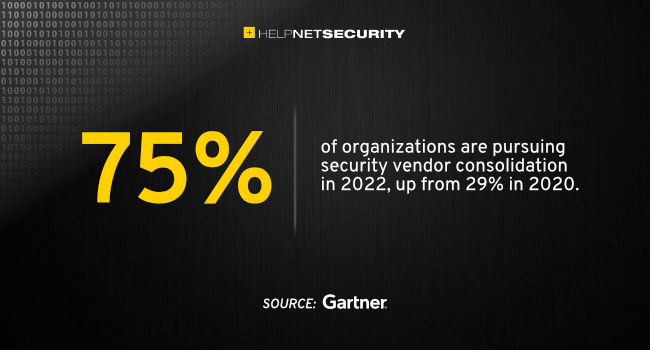Most organizations consolidate to improve risk posture
A recent survey by Gartner found that 75% of organizations are pursuing security vendor consolidation in 2022, up from 29% in 2020.

“Security and risk management leaders are increasingly dissatisfied with the operational inefficiencies and the lack of integration of a heterogenous security stack,” said John Watts, VP Analyst at Gartner. “As a result, they are consolidating the number of security vendors they use.”
The survey found that 57% of organizations are working with fewer than 10 vendors for their security needs, as they are looking to optimise to fewer vendors in key areas like secure access service edge (SASE) and extended detection and response (XDR).
The survey was conducted online during March and April 2022 among 418 respondents from North America, Asia Pacific and EMEA. Its objective was to determine organizations’ security vendor consolidation efforts and priorities, and the drivers and benefits of consolidation endeavours.
Improving risk posture is the No. 1 benefit of consolidation
The survey found that organizations want to consolidate their security vendors to reduce complexity and improve risk posture, not to save on budget or to improve procurement. Sixty-five per cent of surveyed organizations expect to improve their overall risk posture, and only 29% of respondents expect reduced spending on licensing.
“Cost optimization should not be the primary driver for vendor consolidation,” said Watts. “Organizations that look to optimize costs must reduce products, licenses and features, or ultimately renegotiate contracts.”
Organizations that have not pursued security vendor consolidation yet indicated that the two primary impediments to consolidation were time constraints and having a vendor partnership that is too rigid (34% of respondents for each answer).
SASE and XDR are opportunities for consolidation
Lengthy procurement processes or requests for proposals are allowing for consolidated offerings, such as XDR for endpoints and SASE for edge connectivity and security with integration on the backend.
The survey found that 41.5% of respondents plan to have adopted SASE within their organizations by the end of 2022, while 54.5% of organizations have plans to adopt XDR by the end of 2022.
“Security and risk management leaders must consider XDR and SASE as compelling options to start their consolidation journey,” said Dionisio Zumerle, VP Analyst at Gartner. “SASE provides secure enterprise access, while XDR focuses on detecting and responding to threats through increased visibility on networks, cloud, endpoints and other components.”
In fact, the survey found that 57% of organizations resolved security threats faster after implementing an XDR strategy. More than half of surveyed organizations use SASE projects to simplify network and security policy management and improve security posture.
“While 89% of surveyed organizations want SASE and XDR to work together, security and risk management leaders will often opt to keep them distinct from one another but ensure they can interoperate,” said Zumerle. “This is an approach validated by 46% of surveyed organizations, which allows for flexibility to select best-of-breed functionality.”
“Security and IT leaders should plan at least two years for consolidation as it takes time to effectively consolidate and consider incumbent vendor switching costs,” said Watts. “It is also important to anticipate vendor M&A disruption as the security market is always consolidating but never consolidated.”